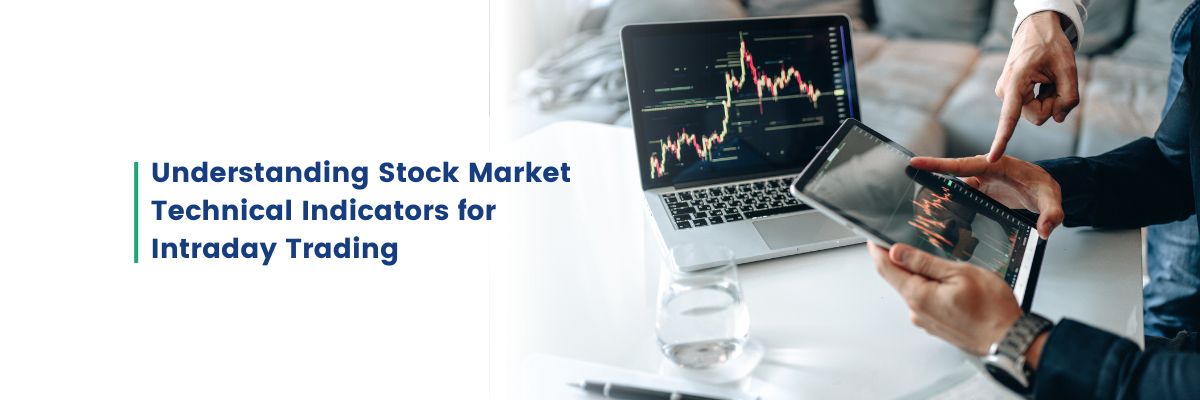In the ever-fluctuating stock market landscape, comprehending technical indicators for intraday trading plays a pivotal role. Technical analysis indicators are essential tools used by traders to gauge market movements. They encompass various types of technical indicators, such as moving averages, Relative Strength Index (RSI), MACD, Bollinger Bands, volume oscillators, and stochastic oscillators, among others. Understanding and utilizing these best technical indicators enable traders to make informed decisions within the fast-paced realm of intraday trading.
Common Technical Indicators and Their Interpretation
- Moving Averages: Technical indicators like moving averages are crucial for intraday trading strategies. Traders often use short-term moving averages, such as the 9-period or 21-period, to swiftly capture price movements within a single trading day. The crossover of short-term and long-term moving averages can signal potential entry or exit points during intraday sessions.
- Relative Strength Index (RSI): When focusing on technical indicators for intraday trading, RSI serves as a valuable tool to identify overbought or oversold conditions within shorter timeframes. Intraday traders typically adjust RSI settings to shorter periods, like 5 or 14, for swift insights into intraday market sentiment.
- MACD (Moving Average Convergence Divergence): The MACD, known for its versatility, holds immense significance for intraday traders. Its histogram and signal line assist in spotting short-term trends, aiding in quick decision-making during intraday sessions.
- Bollinger Bands: For intraday traders, Bollinger Bands provide visual cues regarding volatility and price movements within a single trading day. Utilizing narrower bands during intraday analysis helps traders identify potential breakout or reversal points in real-time.
- Volume Oscillator: Intraday trading heavily relies on volume trends, making volume oscillators indispensable technical indicators. Tracking volume changes within the trading day assists traders in confirming price movements and strengthening their intraday strategies.
- Stochastic Oscillator: Shorter timeframes in intraday trading benefit from stochastic oscillators to identify rapid price movements. Adjusting parameters for intraday analysis, such as a 5-3-3 setting, aids in capturing short-term market conditions.
- Average True Range (ATR): In the realm of intraday trading, the Average True Range stands out as a crucial indicator to gauge market volatility. It showcases the average price range of a security over a specified period, providing intraday traders with insights into potential price movements. A higher ATR indicates increased volatility, guiding traders in adjusting their intraday strategies to accommodate market fluctuations.
- Ichimoku Cloud: The Ichimoku Cloud, with its multi-dimensional components like the Kumo (cloud), Tenkan-sen (conversion line), and Kijun-sen (base line), offers a comprehensive view of intraday trends. For intraday traders, this indicator assists in identifying support and resistance levels, as well as potential entry or exit points, contributing to effective intraday decision-making.
- On-Balance Volume (OBV): OBV, a volume-based indicator, adds an extra layer of confirmation to intraday trading decisions. It tracks buying and selling pressure by analyzing volume flow. Intraday traders rely on OBV to confirm price movements: a rising OBV corroborates upward price movements, while a decreasing OBV validates downtrends, aiding in intraday trend analysis.
- Parabolic SAR: This trailing stop-and-reverse indicator helps intraday traders establish potential stop-loss levels. Parabolic SAR, marked by dots above or below price movements, assists in identifying intraday trends and potential reversal points, facilitating risk management for intraday positions.
- ADX (Average Directional Index): Intraday traders leverage the ADX to determine the strength of intraday trends. A rising ADX suggests a strengthening trend, while a falling ADX indicates a weakening trend. Incorporating the ADX into intraday analysis empowers traders to distinguish between ranging and trending market conditions.
Interpretation and Application
Understanding and effectively applying an array of technical indicators is vital for successful intraday trading strategies:
Moving Averages, RSI, MACD, Bollinger Bands, Volume Oscillator, and Stochastic Oscillator: These time-tested technical indicators serve as pillars in intraday trading, offering valuable insights into short-term price movements. Traders adept at interpreting these indicators within intraday timeframes gain a competitive edge in making informed decisions.
Average True Range (ATR): When woven into intraday strategies, the ATR helps traders anticipate potential intraday price movements by measuring market volatility. Intraday traders swiftly adapt their strategies based on ATR readings, ensuring adjustments to accommodate changing market conditions.
Ichimoku Cloud: Incorporating the Ichimoku Cloud in intraday analysis equips traders with a holistic view of intraday trends. The Cloud's components aid in swift identification of potential intraday entry or exit points, adding depth to intraday decision-making.
On-Balance Volume (OBV): Adding a volume-based perspective to intraday trades, OBV serves as a confirming indicator for price movements. Intraday traders leverage OBV to validate intraday trends and fine-tune their intraday strategies accordingly.
Parabolic SAR, and ADX: These technical indicators, tailored for intraday trading, contribute to refining intraday strategies. Parabolic SAR assists in intraday trend identification and risk management whereas ADX aids in gauging intraday trend strength, guiding traders through dynamic intraday market conditions.
Understanding how these indicators interact within intraday timeframes enriches traders' abilities to decode rapid price movements and make calculated intraday decisions. Incorporating a mix of these indicators into intraday strategies enhances the precision and agility needed for successful intraday trading.
Concluding Thoughts
Mastering technical indicators for intraday trading requires continual learning and hands-on experience. Integrating these indicators into intraday strategies empowers traders to navigate the dynamic stock market environment successfully. The ability to swiftly interpret signals and adapt intraday strategies is key to thriving in the world of intraday trading using technical analysis indicators.
To kickstart your journey, take the first step by opening a Demat cum trading account. Access a range of tools and resources to implement your technical analysis strategies effectively. Additionally, equip yourself with the advantage of staying ahead in the market by downloading "GEPL Pro Markets" our mobile trading app. Trade on-the-go and monitor intraday movements with ease and convenience, ensuring you're always in control of your intraday trades.
Before investing, don't forget to read the disclaimer—it's a small step that can save you from big surprises!






.webp)

